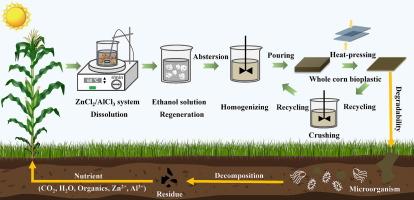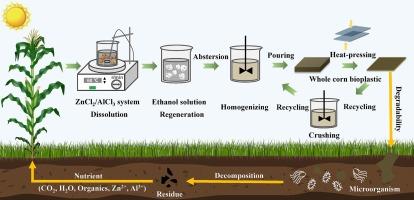A robust, recyclable, and biodegradable whole corn bioplastic enabled by dissolution-regeneration strategy
IF 13.2
1区 工程技术
Q1 ENGINEERING, CHEMICAL
引用次数: 0
Abstract
Biomass-based plastic, derived from renewable and biodegradable resources such as plant materials, offers a promising solution to mitigate the severe energy and environmental issues caused by petroleum-based plastics. While challenges remain in addressing complex and costly processing produces, as well as improving mechanical properties and water resistance in bioplastic production, these factors hinder the widespread application of bioplastic. Herein, we proposed a facile and cost-efficient method to prepare high-performance bioplastics from whole corn by dissolving it in a green metal salt solution system (ZnCl2/AlCl3 system) to deconstruct into a homogeneous and viscous precursor slurry, and then regenerating it from ethanol to form a dense hydrogen and ionic crosslinking network. The prepared whole corn-based bioplastic has a uniform and dense structure, exhibiting excellent mechanical properties (78.5 MPa), water stability, thermostability, and recyclability. Owing to entirely biomass-based components and their effective processes, bioplastic is biodegradable and has low environmental impact. This strategy provides an avenue for the scalable production of large-scale production of high-performance, environmental, renewable, and biodegradable bioplastic, thus demonstrating a promising alternative for reducing the consumption of petroleum resources.


通过溶解-再生策略实现坚固、可回收和可生物降解的全玉米生物塑料
生物质塑料源自植物材料等可再生和可生物降解的资源,为缓解石油基塑料造成的严重能源和环境问题提供了一种前景广阔的解决方案。虽然在生物塑料生产过程中,解决复杂且成本高昂的加工生产问题以及改善机械性能和耐水性方面仍存在挑战,但这些因素阻碍了生物塑料的广泛应用。在此,我们提出了一种简便、经济高效的方法,利用全玉米制备高性能生物塑料,将其溶解在绿色金属盐溶液体系(ZnCl2/AlCl3 体系)中,解构成均匀、粘稠的前体浆料,然后用乙醇使其再生,形成致密的氢离子交联网络。制备的全玉米基生物塑料具有均匀致密的结构,表现出优异的机械性能(78.5 兆帕)、水稳定性、热稳定性和可回收性。由于完全采用生物质成分及其有效工艺,生物塑料可生物降解,对环境影响小。这一战略为大规模生产高性能、环保、可再生和可生物降解的生物塑料提供了一条途径,从而为减少石油资源的消耗提供了一种前景广阔的替代方案。
本文章由计算机程序翻译,如有差异,请以英文原文为准。
求助全文
约1分钟内获得全文
求助全文
来源期刊

Chemical Engineering Journal
工程技术-工程:化工
CiteScore
21.70
自引率
9.30%
发文量
6781
审稿时长
2.4 months
期刊介绍:
The Chemical Engineering Journal is an international research journal that invites contributions of original and novel fundamental research. It aims to provide an international platform for presenting original fundamental research, interpretative reviews, and discussions on new developments in chemical engineering. The journal welcomes papers that describe novel theory and its practical application, as well as those that demonstrate the transfer of techniques from other disciplines. It also welcomes reports on carefully conducted experimental work that is soundly interpreted. The main focus of the journal is on original and rigorous research results that have broad significance. The Catalysis section within the Chemical Engineering Journal focuses specifically on Experimental and Theoretical studies in the fields of heterogeneous catalysis, molecular catalysis, and biocatalysis. These studies have industrial impact on various sectors such as chemicals, energy, materials, foods, healthcare, and environmental protection.
文献相关原料
公司名称
产品信息
阿拉丁
Crystalline aluminum chloride
阿拉丁
Zinc chloride
阿拉丁
Corn starch
 求助内容:
求助内容: 应助结果提醒方式:
应助结果提醒方式:


